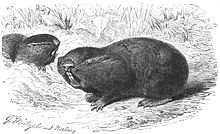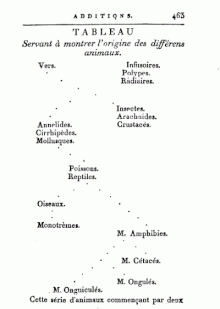Philosophie zoologique
The book was read carefully, but its thesis rejected, by nineteenth century scientists including the geologist Charles Lyell and the comparative anatomist Thomas Henry Huxley.
[3]He argued that gaps between differing kinds of animals resulted from the extinction of intermediate forms, in: a branching series, irregularly graduated which has no discontinuity in its parts, or which, at least, if it's true that there are some because of lost species, has not always had such.
The historian of science Richard Burkhardt argues that this was because Lamarck was convinced his views would be poorly received, and made little effort to present his theory persuasively.
However, he made more of an impact outside France and after his death, where leading scientists such as Ernst Haeckel, Charles Lyell and Darwin himself recognised him as a major zoologist, with theories that presaged Darwinian evolution.
[1] In 1830–1833, Charles Lyell, in his Principles of Geology, carefully summarised Lamarck's theory (in about 6 pages, with cross-references to the Philosophie zoologique) and then roundly criticised it.
Lyell begins by noting that Lamarck gives no examples at all of the development of any entirely new function ("the substitution of some entirely new sense, faculty, or organ") but only proves that the "dimensions and strength" of some parts can be increased or decreased.
By the repeated stretching of their toes, the skin which united them at the base, acquired a habit of extension, until, in the course of time, the broad membranes which now connect their extremities were formed.
[9]Lyell similarly criticises the way Lamarck supposed the antelope and gazelle acquired "light agile forms" able to run swiftly; or the "camelopard" (giraffe) became "gifted with a long flexible neck".
[9] Lamarckism was popularised in the English-speaking world by the speculative Vestiges of the Natural History of Creation, published anonymously by Robert Chambers in 1844.
[10] In 1887 Thomas Henry Huxley, the comparative anatomist known as "Darwin's Bulldog" for his energetic advocacy of Darwinian evolution,[11] wrote that With respect to the Philosophie Zoologique, it is no reproach to Lamarck to say that the discussion of the Species question in that work, whatever might be said for it in 1809, was miserably below the level of the knowledge of half a century later.
In that interval of time the elucidation of the structure of the lower animals and plants had given rise to wholly new conceptions of their relations; histology and embryology, in the modern sense, had been created; physiology had been reconstituted; the facts of distribution, geological and geographical, had been prodigiously multiplied and reduced to order.
To any biologist whose studies had carried him beyond mere species-mongering in 1850, one-half of Lamarck's arguments were obsolete and the other half erroneous, or defective, in virtue of omitting to deal with the various classes of evidence which had been brought to light since his time.
I do not think that any impartial judge who reads the Philosophie Zoologique now, and who afterwards takes up Lyell's trenchant and effectual criticism (published as far back as 1830), will be disposed to allot to Lamarck a much higher place in the establishment of biological evolution than that which Bacon assigns to himself in relation to physical science generally,—buccinator tantum.


